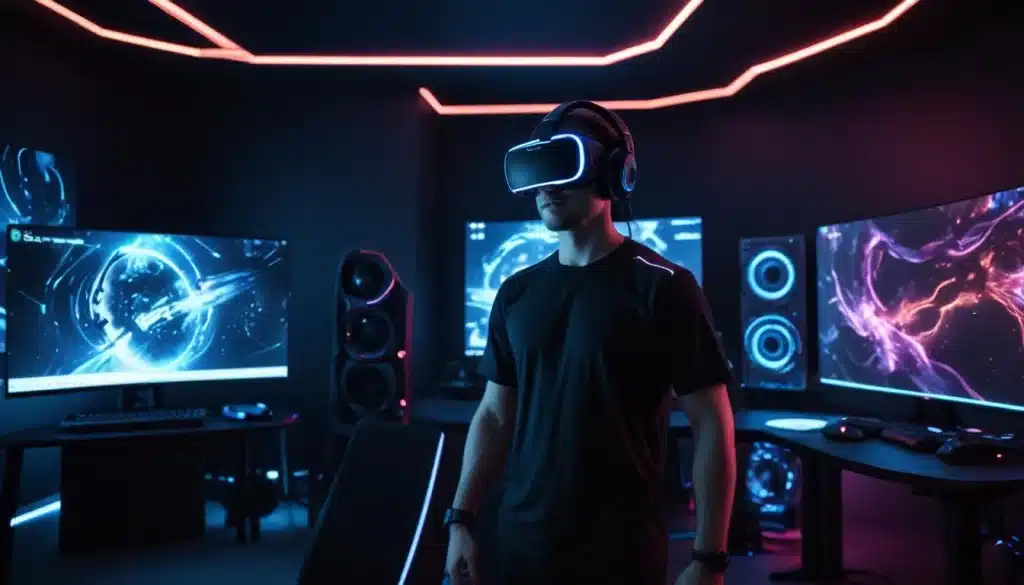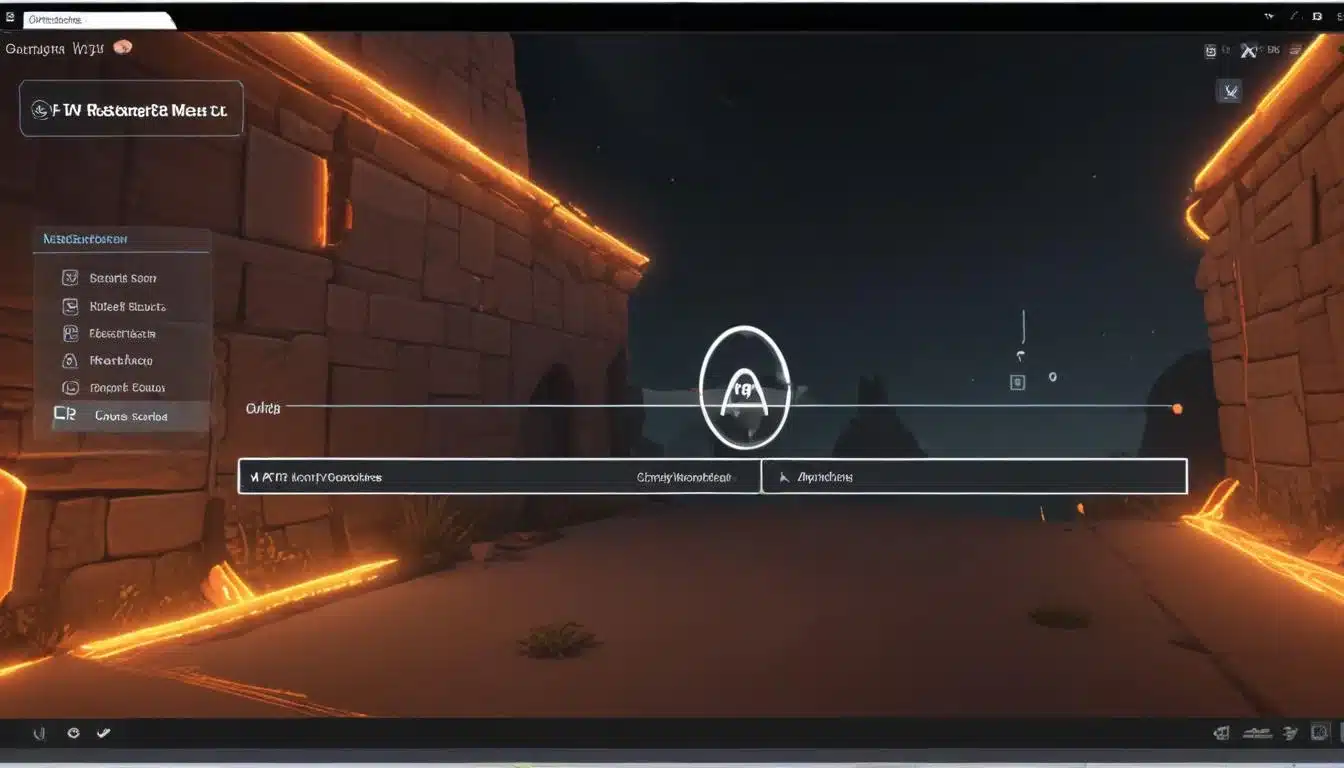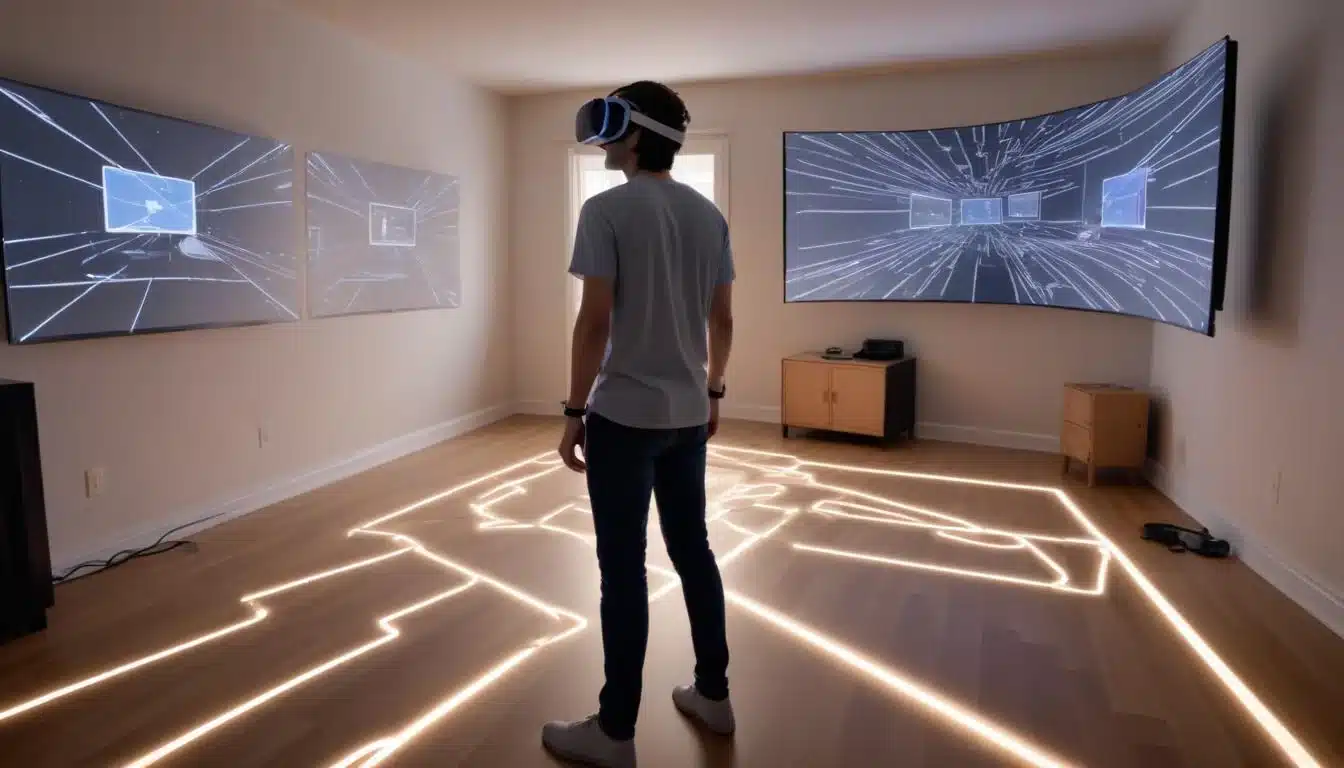PC Virtual Reality: Set Up Your VR Headset for Immersive Gaming in 2025

Setting up your PC VR headset for immersive gaming in 2025 demands a strategic approach to hardware selection, play area optimization, and software configuration to unlock unparalleled virtual experiences.
Are you ready to transcend traditional gaming and immerse yourself in breathtaking virtual worlds? As 2025 unfolds, the landscape of virtual reality gaming on PC is more vibrant and accessible than ever. This guide will walk you through everything you need to know to successfully PC Virtual Reality: Set Up Your VR Headset for Immersive Gaming in 2025, ensuring you unlock the full potential of your VR experience. From selecting the right gear to fine-tuning your settings, prepare to step into the future of entertainment.
Understanding the PC VR Ecosystem in 2025
The PC VR ecosystem in 2025 has matured significantly, offering a diverse range of headsets and sophisticated tracking technologies. Gone are the days of limited options; today’s market caters to various budgets and preferences, from all-in-one solutions that can tether to a PC to dedicated PC-only powerhouses. Understanding these options is the first step towards building your ultimate immersive setup.
As technology continues to evolve rapidly, the line between standalone VR and PC VR becomes increasingly blurred, with many devices offering hybrid capabilities. This flexibility allows users to enjoy both untethered experiences and the graphical fidelity that only a powerful gaming PC can deliver. Deciding which path to take depends largely on your existing hardware and your desired level of immersion and visual fidelity.
Key VR Headset Types
- Dedicated PC VR Headsets: These headsets are designed exclusively for PC use, leveraging the computer’s processing power for superior graphics and performance. Examples include Valve Index and certain Pimax models.
- Hybrid Headsets: Devices like the Meta Quest series offer both standalone functionality and the option to connect to a PC for more demanding VR titles. This versatility makes them popular choices.
- Future Innovations: Expect to see more advanced haptic feedback, wider fields of view, and higher resolution displays becoming standard across the board, pushing the boundaries of what’s possible in virtual worlds.
The choice of headset profoundly impacts your overall VR experience. Consider factors like resolution, refresh rate, field of view, and the comfort of the device for extended play sessions. Each type offers distinct advantages, influencing everything from visual clarity to the physical freedom you’ll have while gaming. Researching current models and their specifications is crucial for making an informed decision that aligns with your gaming aspirations in 2025.
Essential PC Hardware for Optimal VR Performance
To truly experience the cutting edge of PC VR in 2025, your computer needs to be a beast. Virtual reality demands significant processing power, a robust graphics card, and ample RAM to render complex environments at high frame rates without latency. Skimping on hardware will inevitably lead to a less immersive, potentially nauseating experience, undermining the very essence of VR gaming.
The core components of your PC—CPU, GPU, and RAM—work in concert to deliver the virtual world to your eyes. A powerful graphics card is perhaps the most critical component, as it’s responsible for rendering two high-resolution images simultaneously, one for each eye. Moreover, the CPU handles the game logic, physics, and AI, while sufficient RAM ensures smooth data flow, preventing bottlenecks.
Recommended Specifications for 2025
- Graphics Card (GPU): NVIDIA GeForce RTX 4070 or AMD Radeon RX 7800 XT equivalent or better. These cards offer the necessary horsepower for high resolutions and refresh rates.
- Processor (CPU): Intel Core i7-13700K or AMD Ryzen 7 7700X equivalent or better. A fast CPU ensures smooth game logic and reduces stuttering.
- RAM: 32GB DDR5. While 16GB might suffice for some titles, 32GB provides a comfortable buffer for demanding VR applications and multitasking.
- Storage: NVMe SSD (1TB minimum). Fast storage reduces loading times significantly, getting you into the action quicker.
Beyond the core components, ensure your power supply unit (PSU) can adequately support all your hardware, especially if you’re upgrading. Adequate cooling is also vital to prevent thermal throttling during intense VR sessions, which can degrade performance. Investing in a powerful and balanced PC build is paramount for a seamless and breathtaking PC VR gaming experience in 2025.
Setting Up Your VR Play Space
The physical environment where you experience VR is just as important as your hardware. A well-prepared play space ensures safety, maximizes immersion, and prevents accidental collisions with real-world objects. Improper setup can lead to frustration, damage to equipment, or even injury. Taking the time to optimize your play area is a non-negotiable step for any serious PC VR enthusiast.
Before donning your headset, clear a designated area free of obstacles. This space will be your virtual arena, and its boundaries should be respected both virtually and physically. Consider the type of VR experience you’re aiming for: room-scale VR requires more space for movement, while seated or standing experiences can be accommodated in smaller areas. Always prioritize safety and comfort.

Optimizing Your Environment
- Clear Obstacles: Remove furniture, pets, and any other items that could be tripped over or bumped into. Think about a 6.5 x 6.5 feet (2 x 2 meters) area for room-scale VR.
- Define Boundaries: Utilize your VR system’s guardian or chaperone system to clearly mark your play area. This virtual boundary will appear when you get too close to the edge, preventing you from accidentally stepping outside.
- Lighting: Ensure consistent, ambient lighting. Overly bright or dark environments can sometimes interfere with tracking systems. Avoid direct sunlight which can damage headset lenses and affect tracking.
- Cable Management: If using a tethered headset, manage your cables effectively to prevent tripping. Cable management systems, such as ceiling pulleys, can greatly enhance freedom of movement.
Reflecting surfaces like mirrors or glossy paintings can sometimes confuse VR tracking systems, so it’s advisable to cover or remove them if you encounter tracking issues. Sound is also a crucial element; use quality headphones to fully immerse yourself and block out real-world distractions. A thoughtfully designed VR play space elevates your gaming beyond mere visuals, making virtual worlds feel truly tangible.
Software Installation and Configuration
Once your hardware is in place and your play space is optimized, the next crucial step is installing and configuring the necessary software. This includes your VR platform’s client, drivers for your headset and accessories, and any specific optimization tools. Proper software setup ensures your hardware communicates effectively, delivering the optimal performance required for immersive gaming.
Each VR ecosystem, be it SteamVR, Oculus PC, or others, has its own client software that manages your headset, controllers, and game library. Installing these platforms correctly and keeping them updated is essential for stability and access to the latest features. Furthermore, ensuring your graphics card drivers are current is paramount, as new driver versions often include VR-specific optimizations.
Step-by-Step Software Setup
- Install VR Platform Software: Download and install the client software for your specific VR headset (e.g., SteamVR for Valve Index, Oculus PC app for Meta Quest via Link).
- Update Drivers: Ensure your graphics card drivers are up-to-date. Visit NVIDIA or AMD’s website directly for the latest versions. Also, check for any specific drivers for your VR headset.
- Run Setup Wizard: Most VR platforms include a setup wizard that guides you through connecting your headset, pairing controllers, and defining your play space boundaries. Follow these instructions carefully.
- Calibrate Tracking: If your system requires external base stations, ensure they are positioned correctly and calibrated according to the manufacturer’s guidelines for accurate tracking.
Beyond the initial setup, delve into the settings of your VR platform and individual games. Adjusting resolution, refresh rate, and supersampling can significantly impact visual quality and performance. Experiment with these settings to find the sweet spot that balances fidelity with smooth gameplay on your specific PC configuration. A meticulously configured software environment is the backbone of a stellar PC VR experience.

Optimizing Performance for Immersive Gaming
Achieving truly immersive PC VR gaming in 2025 goes beyond basic setup; it requires fine-tuning your system for peak performance. Even with top-tier hardware, suboptimal settings can lead to dropped frames, visual artifacts, and a less convincing virtual presence. Understanding how to optimize your system ensures that every virtual world you enter is as smooth and lifelike as possible.
Optimization is a continuous process, as game developers and hardware manufacturers constantly release updates that can affect performance. It involves a balance of in-game settings, VR platform configurations, and even operating system adjustments. The goal is to maintain a consistent high frame rate, which is crucial for preventing motion sickness and enhancing the feeling of presence.
Advanced Optimization Techniques
- Supersampling: Increase the render resolution beyond your headset’s native resolution. This can dramatically improve visual clarity but is very demanding on your GPU. Start small and increase gradually.
- Refresh Rate: Set your headset’s refresh rate to the highest stable option your PC can maintain. Higher refresh rates (e.g., 90Hz, 120Hz) lead to smoother motion and reduced motion sickness.
- Asynchronous Spacewarp/Motion Smoothing: These technologies (Oculus ASW, SteamVR Motion Smoothing) can generate interpolated frames when your PC can’t hit the target frame rate, helping to maintain smoothness.
- Background Processes: Close unnecessary applications and background processes before launching VR games to free up CPU and RAM resources.
- Game-Specific Settings: Adjust in-game graphics settings. Reduce shadows, anti-aliasing, and complex lighting effects if you’re struggling to maintain a stable frame rate.
Monitoring your PC’s performance using tools like MSI Afterburner or your VR platform’s built-in performance overlay can provide valuable insights into bottlenecks. Pay attention to GPU utilization, CPU usage, and frame times. Experimentation is key; what works best for one game or system might not be ideal for another. Diligent optimization transforms a good VR experience into an extraordinary one, making your virtual adventures truly unforgettable.
Troubleshooting Common VR Issues
Even with the most meticulous setup, you might encounter issues when diving into PC VR. From tracking glitches to performance hiccups, troubleshooting is an inevitable part of the VR journey. Knowing how to diagnose and resolve common problems quickly can save you a lot of frustration and get you back into your immersive games faster.
Many VR issues stem from software conflicts, outdated drivers, or environmental factors. A systematic approach to troubleshooting, starting with the simplest solutions, is often the most effective. Remember that the VR ecosystem is complex, involving multiple layers of hardware and software that must work in perfect harmony.
Common Problems and Solutions
- Tracking Issues: Ensure your play space has consistent lighting, no reflective surfaces, and your base stations (if applicable) are positioned correctly. Check for obstructions blocking sensors.
- Performance Stutter/Lag: Update your graphics drivers. Reduce in-game graphics settings or VR platform render resolution. Close background applications. Check for CPU or GPU overheating.
- Display Problems (Black Screen, Flickering): Verify all cables are securely connected. Restart your VR headset and PC. Check for driver conflicts or VR platform software updates.
- Controller Pairing Issues: Ensure controllers are charged. Restart controllers and the VR headset. Re-pair controllers through your VR platform’s settings.
- Audio Problems: Confirm your VR headset is selected as the default audio output device in Windows sound settings. Check headset audio connections.
When all else fails, consult the online communities and support forums for your specific VR headset or game. Chances are, someone else has encountered a similar problem and found a solution. Keeping your software updated, maintaining a clean play space, and understanding your system’s capabilities will significantly reduce the frequency of issues, allowing you to focus on the incredible worlds awaiting you in PC VR.
The Future of PC VR Gaming in 2025 and Beyond
As we look beyond 2025, the future of PC VR gaming promises even greater immersion, accessibility, and technological marvels. The rapid pace of innovation suggests that virtual reality will become an even more integral part of the gaming landscape, pushing the boundaries of what players can experience. Preparing for this future means staying informed about emerging trends and technologies.
Advances in display technology, haptic feedback, and AI-driven content generation are set to revolutionize how we interact with virtual worlds. Expect to see lighter, more comfortable headsets with even higher resolutions and wider fields of view, making the virtual indistinguishable from reality. Furthermore, the integration of eye-tracking and foveated rendering will allow for unprecedented graphical fidelity with reduced computational demands.
Emerging Trends and Innovations
- Haptic Feedback Suits: Full-body haptic suits are becoming more sophisticated, allowing players to feel impacts, textures, and temperatures within the virtual world, adding another layer of immersion.
- Brain-Computer Interfaces (BCI): Early-stage BCIs could allow for direct neural control and feedback, blurring the lines between thought and action in VR.
- Cloud VR: Streaming VR experiences from powerful remote servers could make high-fidelity VR accessible to a wider audience, reducing the need for costly local hardware.
- Augmented Reality Integration: Expect a continued convergence of VR and AR, leading to mixed-reality experiences that blend virtual elements seamlessly into the real world.
The development of more intuitive interfaces, advanced social VR platforms, and increasingly realistic virtual environments will continue to redefine gaming. As developers harness these new tools, the experiences available in PC VR will become more diverse, engaging, and emotionally resonant. Staying ahead of these trends will position you at the forefront of the next generation of immersive entertainment, making your investment in PC VR in 2025 a truly future-proof decision.
| Key Aspect | Brief Description |
|---|---|
| Hardware Essentials | High-end GPU, strong CPU, and 32GB DDR5 RAM are crucial for optimal 2025 PC VR. |
| Play Space Setup | Clear a safe, obstacle-free zone and use guardian systems for immersion and safety. |
| Software Optimization | Keep VR platforms and graphics drivers updated; fine-tune settings like supersampling. |
| Troubleshooting Tips | Address tracking issues, performance lags, and display problems methodically for smooth play. |
Frequently Asked Questions About PC VR Setup in 2025
While minimum specs vary by headset, for a decent experience in 2025, aim for at least an NVIDIA RTX 3060 or AMD RX 6700 XT GPU, an Intel Core i5-12600K or AMD Ryzen 5 5600X CPU, and 16GB of DDR4 RAM. However, higher specs are recommended for optimal performance and future-proofing.
While a dedicated, clear play space is ideal for room-scale VR, many can use their living room. Just ensure it’s free of obstacles, especially for active games. Always utilize your headset’s guardian system to prevent accidental collisions and enhance safety during gameplay.
For tethered PC VR, internet speed is less critical than for standalone or cloud VR, mainly affecting game downloads and online multiplayer. However, a stable and fast connection is always beneficial for updates and accessing online content without interruptions, ensuring a smooth overall experience.
Effective cable management is crucial for tethered headsets. Consider ceiling-mounted pulley systems to keep cables off the floor and out of your way. Alternatively, secure cables along the wall or use cable ties to minimize tripping hazards and increase freedom of movement while playing. Wireless adapters are also an option for some headsets.
Both are vital, but a high refresh rate (90Hz+) often contributes more to immersion and comfort by reducing motion sickness. If your PC can handle it, increasing resolution (supersampling) enhances visual clarity. Aim for a balance where you maintain a stable high frame rate with the highest possible resolution for your system.
Conclusion
Setting up your PC VR headset for immersive gaming in 2025 is a journey that combines careful hardware selection, thoughtful space preparation, and meticulous software optimization. By following these guidelines, you’re not just configuring a device; you’re unlocking portals to countless virtual worlds. The future of gaming is here, and with the right setup, you’re ready to explore its boundless possibilities, experiencing a level of immersion that redefines entertainment.